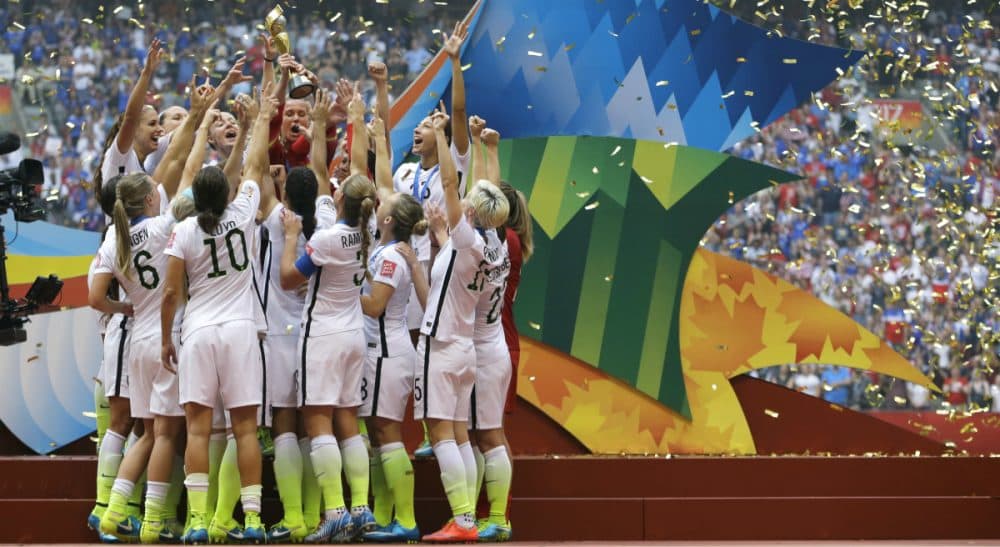Advertisement
Women's World Cup Soccer, And Why I Had To Watch

Let me stipulate at the outset: I’m a fair weather soccer fan. I watched a couple of games in the last Men’s World Cup, but I hadn’t seen a women’s soccer game since the U.S. team beat China in 1999. (And to be mortifyingly honest, what I remember most from that event is Brandi Chastain’s now so quaintly shocking display of her sports bra, not the winning penalty kick that preceded it.) So when I tuned in to the American team’s first televised match in this year’s competition, I asked myself why.
I watched the Women’s World Cup in the hope that, as with tennis (and unlike basketball), I’d find female athletes as compelling to watch as the boys.
Did I want to be able to join the water cooler conversation at work, except that we have no water cooler, nor had I heard any of my colleagues actually express much interest in this World Cup? Was I just looking for some spectator sport distraction during this endless baseball season, especially since the Red Sox are so dismal, and I’m feeling increasingly queasy about being a football fan. Could I be more bellicose than I like to admit, itchy for someone to cheer for and someone to boo? But surely not. After all, the 2016 electoral season is already underway, with no shortage of the latter. That wasn't it, either.
No, it was undeniably the fact that this was the Women’s World Cup. I still remember the heady joy of watching Billie Jean King trounce Bobby Riggs in 1973. That “Battle of the Sexes” – admittedly as much circus as sport — was staged just as the second wave of American feminism was reaching its peak. As I sat in a room full of my fellow college students, smoking up a storm, cheering our way through that match with full throats and fiercely hopeful hearts, feminism and women’s athleticism became inextricably paired for me.
I watched the Women’s World Cup in the hope that, as with tennis (and unlike basketball), I’d find female athletes as compelling to watch as the boys.
And in the first few games, I found myself running through a mental checklist. Is the game exciting? Yes, at least as exciting as the men’s game. Are the women as fast? Close enough. Are they tough? Tougher, with just as much tackling, checking and bleeding, but a lot less flopping and diving. Do they high five and fist pump and scream in triumph or rage? Yup, they’re as pumped up as their male counterparts. OK, maybe they don’t chest bump as much, but just as well.
By the quarterfinals, there was clearly no need for this kind of appraisal. These women had nothing to prove, at least nothing pertaining to their athletic prowess. In fact, nothing relevant to their ability to draw fans or viewers, either. In every respect but monetary compensation, these players were equal to their male counterparts. But that’s a huge exception. The total payout for last year’s Men’s World Cup is almost 40 times greater than what FIFA will pay to the women’s teams. Measured only in financial terms, the Women’s World Cup would suggest that society has made no progress at all, rewarding women far better for revealing their bodies than for exerting them. But therein lies the fallacy of using only one measure.
Measured only in financial terms, the Women’s World Cup would suggest that society has made no progress at all.
“I love tennis very much, and I wanted it to change ever since I started in the sport,” Billie Jean King said in a press conference following her match with Riggs 42 years ago. “I thought it was just for the rich and just for the white, and ever since that day when I was 11 years old and I wasn’t allowed in a photo because I wasn’t wearing a tennis skirt, I knew then that I wanted to change the sport, and tonight a lot of non-tennis people saw tennis for the first time. I don’t even care what kind of match it was.”
King’s comments still resonate. The U.S. women’s team -- a product of a club system that requires enough disposable income to pay for uniforms and travel -- still resembles the early days of tennis in the wealth and whiteness of the players. But they also still ring true because, in the past few weeks, and once every four or eight years, a lot of non-soccer people like me watch soccer for the first time. And beyond the sport, we see women not in skirts, but in sports bras, fearless and unbound.

